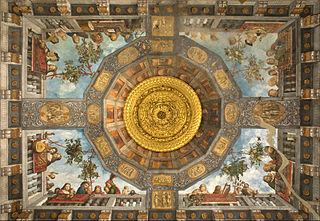
Trompe-l'œil is an artistic term for the highly realistic optical illusion of three-dimensional space and objects on a two-dimensional surface. Trompe l'œil, which is most often associated with painting, tricks the viewer into perceiving painted objects or spaces as real. Forced perspective is a related illusion in architecture.
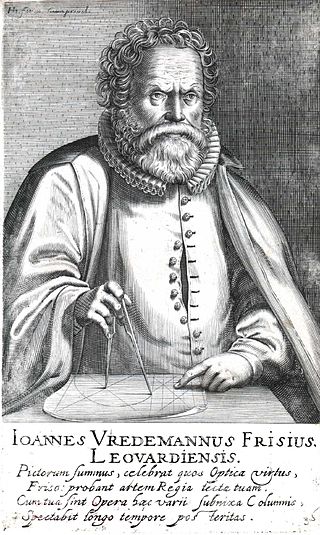
Hans Vredeman de Vries was a Dutch Renaissance architect, painter, and engineer. Vredeman de Vries is known for his publication in 1583 on garden design and his books with many examples on ornaments (1565) and perspective (1604).

Flemish Baroque painting was a style of painting in the Southern Netherlands during Spanish control in the 16th and 17th centuries. The period roughly begins when the Dutch Republic was split from the Habsburg Spain regions to the south with the Spanish recapturing of Antwerp in 1585 and goes until about 1700, when Spanish Habsburg authority ended with the death of King Charles II. Antwerp, home to the prominent artists Peter Paul Rubens, Anthony van Dyck, and Jacob Jordaens, was the artistic nexus, while other notable cities include Brussels and Ghent.

Frans Francken the Younger was a Flemish painter and the best-known and most prolific member of the large Francken family of artists. He painted large altarpieces for churches as well as smaller historical, mythological and allegorical scenes. His depictions of collectors' cabinets established a popular new genre of art in the era. Francken often collaborated with other artists, adding figures and narrative elements to scenes created by specialists in landscape, architectural and floral still life paintings.

Hendrik van Steenwijck II (c.1580–1640) was a Baroque painter mostly of architectural interiors, but also of biblical scenes and still lifes.

Hendrik van Steenwijck I (also Steenwyck, Steenwijk) (c. 1550 – buried 1 September 1603) was a Dutch Golden Age painter, from early in the period, known mainly for his church interiors.
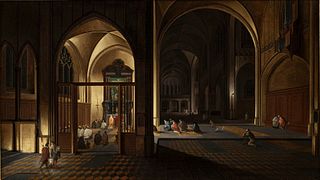
Pieter Neefs the Elder or Pieter Neeffs the Elder was a Flemish painter who specialized in architectural interiors of churches. Active in Antwerp, he was influenced by the works of the Dutch architectural painters Hendrik van Steenwijk the Elder and the Younger. His principal contribution to the genre were his nocturnal church interiors lit by two light sources.
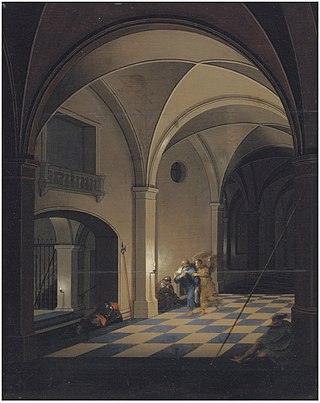
Pieter Neefs the Younger or Pieter Neeffs the Younger was a Flemish painter who mainly specialized in architectural interiors of churches. Son of the prominent architectural painter Pieter Neefs the Elder he started out working in his father's workshop in Antwerp. He collaborated with various leading staffage painters to create lively church interiors.
Dirck van Delen or Dirck Christiaensz van Delen was a Dutch painter who specialized exclusively in architectural paintings, principally depicting palace perspectives and church interiors.

The Cathedral of Santa María, known as the Old Cathedral, is one of the two cathedrals in Salamanca, Castile and León, Spain. Founded by Bishop Jerome of Périgord, its construction began in the first third of the 12th century and was finished at the end of the 14th century, in Romanesque and Gothic style. It was finished thanks to the impulse given to the works by Bishop Alfonso Barasaque. It is dedicated to Saint Mary of the See.

Hendrik Hondius I was a Flemish-born and trained engraver, cartographer, and publisher who settled in the Dutch Republic in 1597.
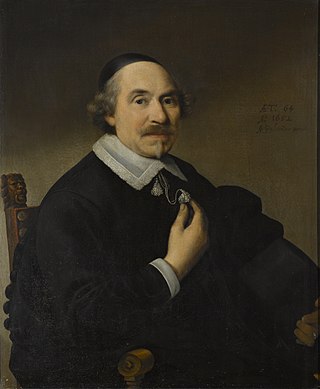
Pieter Anthonisz van Bronckhorst or Bronkhorst, was a Dutch painter active in Delft. He was mainly an architectural painter known for his church interiors and fantasy palaces with small figures representing biblical stories. It is possible he also painted still lifes and was a staffage painter for other painters.

Abel Grimmer was a Flemish late Renaissance painter, mainly of landscapes and, to a lesser extent, of architectural paintings. His works were important in the development towards more naturalism in Flemish landscape painting.

Paul Vredeman de Vries, was a Flemish painter and draughtsman who specialised in architectural paintings and, in particular, church interiors.
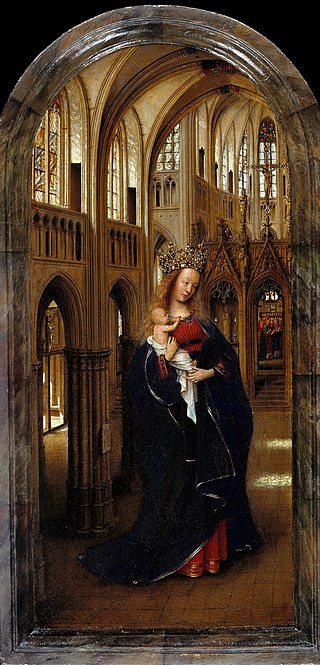
Madonna in the Church is a small oil panel by the early Netherlandish painter Jan van Eyck. Probably executed between c. 1438–1440, it depicts the Virgin Mary holding the Child Jesus in a Gothic cathedral. Mary is presented as Queen of Heaven wearing a jewel-studded crown, cradling a playful child Christ who gazes at her and grips the neckline of her red dress in a manner that recalls the 13th-century Byzantine tradition of the Eleusa icon. Tracery in the arch at the rear of the nave contains wooden carvings depicting episodes from Mary's life, while a faux bois sculpture in a niche shows her holding the child in a similar pose. Erwin Panofsky sees the painting composed as if the main figures in the panel are intended to be the sculptures come to life. In a doorway to the right, two angels sing psalms from a hymn book. Like other Byzantine depictions of the Madonna, van Eyck depicts a monumental Mary, unrealistically large compared to her surroundings. The panel contains closely observed beams of light flooding through the cathedral's windows. It illuminates the interior before culminating in two pools on the floor. The light has symbolic significance, alluding simultaneously to Mary's virginal purity and God's ethereal presence.
Salomon Vredeman de Vries, was a Flemish painter and draughtsman who specialised in architectural paintings.

Hendrick Aerts was a Flemish painter and draftsman who painted mainly architectural paintings and was active in Gdańsk and Prague.

Hieronymus Janssens or Jeroom Janssens was a Flemish genre painter known for his compositions depicting elegant companies engaging in dance, music or play, which were of influence on the development of the genre of the conversation piece. He also painted architectural scenes of real or imaginary palaces, churches, temples and art galleries.
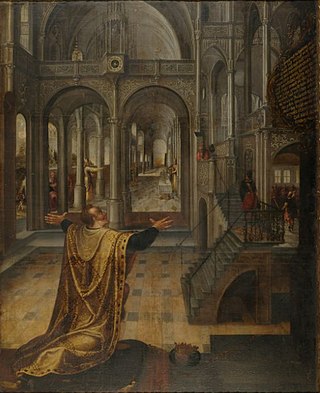
Izaak van den Blocke or Isaak van den Blocke (1574–1626) was a painter of Flemish descent who spent his active career in Poland. He is known for his decorative paintings in various official buildings and residences in Gdańsk. He also completed commissions for churches and painted facades. He was in 1612 one of the founders of the painters' guild of Gdańsk.

Architectural painting is a form of genre painting where the predominant focus lies on architecture, including both outdoor and interior views. While architecture was present in many of the earliest paintings and illuminations, it was mainly used as background or to provide rhythm to a painting. In the Renaissance, architecture was used to emphasize the perspective and create a sense of depth, like in Masaccio's Holy Trinity from the 1420s.






















